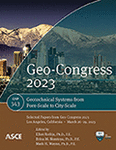Evaluation of Empirical Methods for Estimating Tunneling-Induced Ground Movements—Los Angeles Metro K Line Crenshaw/LAX Transit Project
Publication: Geo-Congress 2023
ABSTRACT
Empirical methods for estimating tunneling-induced ground movements have been widely adopted in the tunneling industry. The transverse surface settlement profile can be described by a Gaussian curve or a modified Gaussian curve whose maximum value and trough width are related to volume loss. Volume loss in turn is related to soil type, tunnel geometry, and construction techniques. Several empirical equations have been developed based on the Gaussian curve and the assumptions of (1) trough width dependency on tunnel depth and ground condition; and (2) volume loss dependency on the ground type and construction techniques. For Earth Pressure Balance Machine (EPBM) tunneling, a volume loss of 0.5% in granular soils and 1%–2% the soft clay has been assumed in the past as an initial estimate. However, with complete filling and pressurization of both the shield (overcut) gap and the grouted tail gap around the lining, volume losses below 0.1% to 0.2% are being achieved in the alluvial granular and clay soils on current Los Angeles Metro tunneling projects. The LA Metro K Line Crenshaw/LAX transit project, tunneled from 2016 to 2018, has provided an opportunity to acquire and organize data on compatible data management systems, and evaluate the extensive field monitoring data for ground conditions specific to predominately granular soils in Old Alluvium. These data allow for the improvement of current empirical methods and correlations for predicting surface settlement induced by EPBM tunnels. The approximately 1-mi (1.6-km)-long, 20.6-ft (6.5-m)-diameter twin tunnels were excavated by an EPBM in a dense sand layer overlain by a silt/clay layer. The cover-to-diameter ratio was consistently about 2. The settlements and volume losses are observed to be heavily dependent on the face/shield pressures. In general, maintaining continuous pressures can significantly reduce settlements. An equation for estimating the volume loss based on the measured EPBM shield pressures is proposed. This equation can be used with the existing empirical methods to estimate the surface settlement profile transverse to the longitudinal axis of the tunnel.
Get full access to this article
View all available purchase options and get full access to this chapter.
REFERENCES
Attewell, P. B., J. Yeates, and A. R. Selby. 1986. Soil Movements Induced by Tunnelling and Their Effects on Pipelines and Structures.
Celestino, T. B., R. A. M. P. Gomes, and A. Airton Bortolucci. 2000. “Errors in Ground Distortions Due to Settlement Trough Adjustment.” Tunneling and Underground Space Technology 15(1): 97–100.
Clough, G. W., and B. Schmidt. 1981. 20 Developments in Geotechnical Engineering Design and Performance of Excavations and Tunnels in Soft Clay. Elsevier Scientific Publishing Company, Amsterdam. https://doi.org/10.1016/B978-0-444-41784-8.50011-3.
Cording, E. J. 2018. Muir Wood Lecture 2018: Monitoring and Controlling Ground Behavior at the Source Recent Applications to Pressurized Tunneling.
Cording, E. J., and W. H. Hansmire. 1975. “Displacements around Soft Ground Tunnels.” General Report, Session 4, 5th Pan American Congress on Soil Mechanics and Foundation Engineering, Buenos Aires.
Farrokh, E., A. Amiri, and A. Hasoomi. 2021. “Volume Loss and Face Pressure Evaluation in Tehran Metro Line 6, South Extension.” Tunneling and Underground Space Technology 116(November 2020): 104113. https://doi.org/10.1016/j.tust.2021.104113.
Hatch Mott MacDonald. 2012a. Geotechnical Baseline Report.
Hatch Mott MacDonald. 2012b. Geotechnical Data Report.
Mair, R. J., R. N. Taylor, and A. Bracegirdle. 1993. “Subsurface Settlement Profiles above Tunnels in Clays.” Geotechnique 43(2): 315–20. https://doi.org/10.1680/geot.1995.45.2.361.
Mair, R. J., and R. N. Taylor. 1997. Theme Lecture: Bored Tunnelling in the Urban Environment. : 536–37.
Marshall, A. M., R. Farrell, A. Klar, and R. Mair. 2012. “Tunnels in Sands: The Effect of Size, Depth and Volume Loss on Greenfield Displacements.” Geotechnique 62(5): 385–99.
Moh, Z. C., D. H. Ju, and R. N. Hwang. 1996. “Ground Movements around Tunnels in Soft Ground.” In Proceeding of Symposium on Geotechnical Aspects of Underground Construction in Soft Ground, 725–30.
Netzel, H. 2009. Building Response Due to Ground Movements. Delft University of Technology.
O’Reilly, M. P., and B. M. New. 1982. “Settlements above Tunnels in the United Kingdom - Their Magnitude and Prediction.” In Tunnelling ’82. Papers Presented at the 3rd International Symposium, ed. J. Michael., 173–81.
Peck, R. B. 1969. “Deep Excavations and Tunnelling in Soft Ground.” In Proceedings of the 7th International Conference on Soil Mechanics and Foundation Engineering, Mexico City, Mexico, 266–90.
Schmidt, B. 1969. Settlements and Ground Movements Associated with Tunneling in Soil. University of Illinois.
Vorster, T. E., A. Klar, K. Soga, and R. J. Mair. 2005. “Estimating the Effects of Tunneling on Existing Pipelines.” Journal of Geotechnical and Geoenvironmental Engineering 131(11): 1399–1410.
Information & Authors
Information
Published In
History
Published online: Mar 23, 2023
Authors
Metrics & Citations
Metrics
Citations
Download citation
If you have the appropriate software installed, you can download article citation data to the citation manager of your choice. Simply select your manager software from the list below and click Download.
